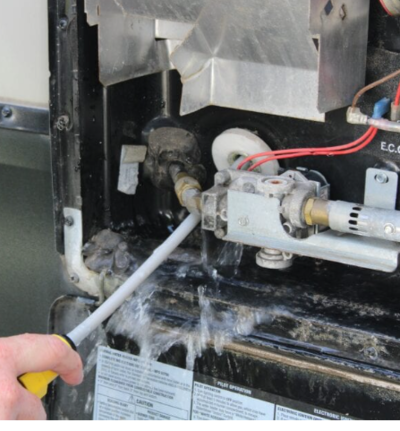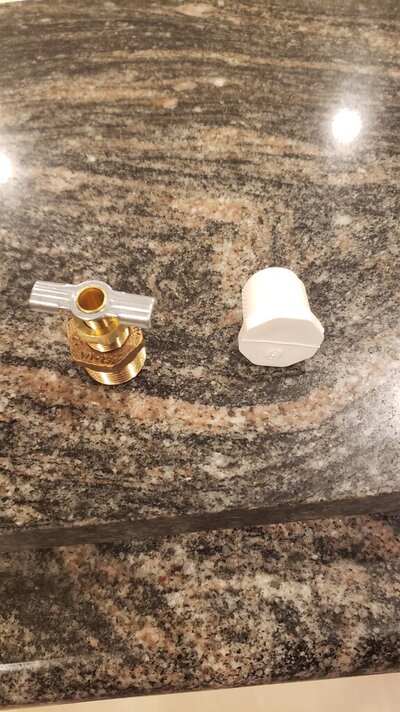You are using an out of date browser. It may not display this or other websites correctly.
You should upgrade or use an alternative browser.
You should upgrade or use an alternative browser.
Water heater plug
- Thread starter skister77
- Start date
The friendliest place on the web for anyone with an RV or an interest in RVing!
If you have answers, please help by responding to the unanswered posts.
If you have answers, please help by responding to the unanswered posts.
Kirk
Well-known member
As long as the petcock is made of brass it should be OK but if you do that you then also need to remove it and flush the mineral deposits out at least once each year. The rush of water out with the plug will carry at least some of the minerals out. Do not use an iron plug on your Atwood/Dometic water heater because it has an aluminum tank and it will create problems.


Last edited:
gwinger
Well-known member
Using the petcock would still require it being removed to flush the tank properly.
That and any buildup in the tank may plug the petcock when draining.
That and any buildup in the tank may plug the petcock when draining.
Rene T
Site Team
Good point and you may think it’s empty when it could be 1/2 or 3/4 full and could freeze if it gets cold enough in your areaUsing the petcock would still require it being removed to flush the tank properly.
That and any buildup in the tank may plug the petcock when draining.
CharlesinGA
Well-known member
I keep a spare plug or two on hand in case I damage the hex on it. Its easy enough to get in and out with the right socket and extension and ratchet. I use pipe dope on the threads. Teflon tape is not the best thing for this application, as it never seems to work very well on plastic threads.
Another reason for the plastic plug is, it is additional insurance to protect you from buggering up the threads in the aluminum tank.
I also take cardboard, such as a canned drink carton, and tape it to the inside of the heater to act as a funnel to direct the water away from the side of the RV. Only takes a minute, I use blue masking tape, which works well enough for the few minutes it will be on there.
Charles
Another reason for the plastic plug is, it is additional insurance to protect you from buggering up the threads in the aluminum tank.
I also take cardboard, such as a canned drink carton, and tape it to the inside of the heater to act as a funnel to direct the water away from the side of the RV. Only takes a minute, I use blue masking tape, which works well enough for the few minutes it will be on there.
Charles
Kirk
Well-known member
Atwood recommends that you use a new plug each time but like you, I didn't do that but I did keep a spare and replace the original at the first sign of damage. I also found that a new plug was easier to seal without leakage than a used one.I keep a spare plug or two on hand in case I damage the hex on it
John From Detroit
Well-known member
I used a 1/2 inch ball valve for a while (Tha'ts a BIG petcock) and had a half inch nipple to screw into it when I drained... With this you can still flush but it's a very tight fit I had to modify the vlave handle. And eventually I had to replace the tank and it did not work on the new tank (leaked)
I'd avoid metal plugs/fittings on the Atwood tank.
I'd avoid metal plugs/fittings on the Atwood tank.
Ray-IN
Well-known member
I've used the same ½ nylon plug for 10 years. This time when I attempted to remove it the hex head twisted off. Now when I de-winterize I've got to use a pipe removal tool to remove the nylon threads.
I do have this handy in my spare parts, 25 ½" NPT nylon pipe plugs for $10. https://www.amazon.com/dp/B07ZYWNSJ...colid=IIT191TPI0O4&psc=1&ref_=lv_ov_lig_dp_it
I do have this handy in my spare parts, 25 ½" NPT nylon pipe plugs for $10. https://www.amazon.com/dp/B07ZYWNSJ...colid=IIT191TPI0O4&psc=1&ref_=lv_ov_lig_dp_it
Rene T
Site Team
You may be able to get it out by driving a large regular screwdriver into the broken plug . Then unscrew it with a crescent wrench or vice grips.I've used the same ½ nylon plug for 10 years. This time when I attempted to remove it the hex head twisted off. Now when I de-winterize I've got to use a pipe removal tool to remove the nylon threads.
I do have this handy in my spare parts, 25 ½" NPT nylon pipe plugs for $10. https://www.amazon.com/dp/B07ZYWNSJ...colid=IIT191TPI0O4&psc=1&ref_=lv_ov_lig_dp_it
Old_Crow
Well-known member
When I bought a replacement plastic plug for mine, they came in a 2-pak.
gwinger
Well-known member
I keep a spare plug or two on hand in case I damage the hex on it. Its easy enough to get in and out with the right socket and extension and ratchet. I use pipe dope on the threads. Teflon tape is not the best thing for this application, as it never seems to work very well on plastic threads.
Another reason for the plastic plug is, it is additional insurance to protect you from buggering up the threads in the aluminum tank.
I also take cardboard, such as a canned drink carton, and tape it to the inside of the heater to act as a funnel to direct the water away from the side of the RV. Only takes a minute, I use blue masking tape, which works well enough for the few minutes it will be on there.
Charles
Instead of pipe dope, use faucet/valve grease, sometimes called plumbers grease. Made for plastic faucet cartridges and valves.
NY_Dutch
Well-known member
When I don't have a nylon plug available, a 1/2" CPVC plug from a hardware store works just as well. I find that keeping a spare right inside the water heater cabinet pretty much insures I'll never need it. 
WILDEBILL308
Well-known member
Just make shure whatever you use has the right thread. The water heater needs "pipe" thread. That fitting with the petcock looks like it has "tubing" threads.
Bill
Bill
Ray-IN
Well-known member
I still have all my toolmakers stuff, so I'll use my pipe removers, kinda like EZ-outs, but with 4 tapered corners.You may be able to get it out by driving a large regular screwdriver into the broken plug . Then unscrew it with a crescent wrench or vice grips.
NY_Dutch
Well-known member
And for those that don't already have a suitable removal tool in their kit, Amazon sells a broken plastic sprinkler head removal tool for $4.41 that's works well for the 1/2" nylon or plastic water heater plugs as well.I still have all my toolmakers stuff, so I'll use my pipe removers, kinda like EZ-outs, but with 4 tapered corners.
Rene T
Site Team
The only downfall is that you can only use it outdoors. So if your rv is in a enclosed building, I guess you can’t use this tool.And for those that don't already have a suitable removal tool in their kit, Amazon sells a broken plastic sprinkler head removal tool for $4.41 that's works well for the 1/2" nylon or plastic water heater plugs as well.
Ray-IN
Well-known member
That closely resembles my EZ out for metal pipe nipple threads.And for those that don't already have a suitable removal tool in their kit, Amazon sells a broken plastic sprinkler head removal tool for $4.41 that's works well for the 1/2" nylon or plastic water heater plugs as well.
NY_Dutch
Well-known member
My guess would be that the quality of the steel used at that price would not stand up well to the effort often needed to remove broken metal piping.That closely resembles my EZ out for metal pipe nipple threads.
Ray-IN
Well-known member
Nope, that sprinkler tool appears to be pot metal, but will do the job for plastic pipe.My guess would be that the quality of the steel used at that price would not stand up well to the effort often needed to remove broken metal piping.

